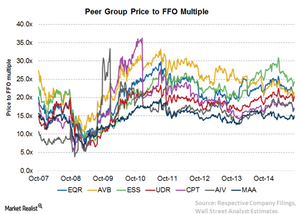Analyzing Equity Residential’s Higher Price-to-FFO Multiple
The most common way to calculate the relative value of a REIT like Equity Residential (EQR) is the price-to-FFO (funds from operations) multiple.
Oct. 6 2015, Updated 9:07 a.m. ET

Price-to-funds from operations multiple
The most common way to calculate the relative value of a REIT like Equity Residential (EQR) is the price-to-FFO (funds from operations) multiple. FFO is widely used because it’s the main earnings metric for REITs. It’s similar to the EPS (earnings per share) in other industries. The price-to-FFO multiple is equivalent to the PE (price-to-earnings) ratio that’s used in other industries.
Peer group price-to-FFO multiple
A closer look at Equity Residential’s trailing 12-month price-to-FFO multiple shows that it’s in line with its historical valuation. Over the last eight years, Equity Residential’s price ranged between 8x and 29.8x of its FFO. It has a current price-to-FFO multiple of around 21.1x. During the housing crisis, Equity Residential experienced the lowest price-to-FFO multiple. The company recorded the highest multiple in July 2011.
At this multiple, Equity Residential’s stock is trading in line with most of its peers except Camden Property (CPT). It’s trading at a much lower multiple of 16.2x. The industry average price-to-FFO multiple is 18.9x. AvalonBay Communities (AVB) is trading at 22x, Essex Property Trust (ESS) is at 22.9x, and UDR (UDR) is at 20.4x.
Higher multiple for Equity Residential
Historically, a higher price-to-FFO multiple for Equity Residential (EQR) signifies that it was able to provide consistent capital value return along with a reliable and steady dividend yield to investors. Currently, Equity Residential offered a dividend yield of 2.92%. This is higher than its close competitors like AvalonBay Communities at 2.85% and Essex Property Trust (ESS) at 2.52%. It’s lower than the industry average of 3.22%. Equity Residential accounts for 6.70% of the iShares Cohen & Steers REIT ETF (ICF).
In the next part of this series, we’ll discuss investing in REITs through ETFs.
